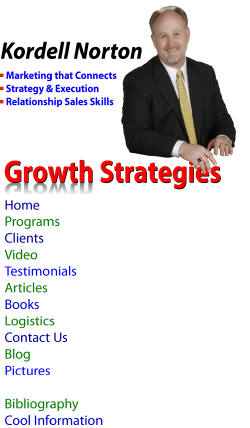

Storyboarding
By Kordell Norton
©Copyright 2007, all rights reserved
Walt Disney’s heroic hero was Leonardo da Vinci. When Disney, ran into a problem he would ask himself, “what would da Vinci do?” When it came to organizing the tens of thousands of drawings that were part of an animated feature film, he went the direction he thought da Vinci would give by using the space on walls. He created a Story Board.
Today storyboards are used extensively in the film industry, as well as hundreds of other applications. Since they allow information to be brainstormed, communicated, or organized in a quick fashion they have become an important tool for individuals or teams. They have been modified by many organizations and called by different names (Navigation Maps, Compression Planning, Flow Charts, etc) . . . but they are all basically the same tool.
Michael Vance, Dean of Disney University for many years indicates that the uses
for a story board can be found in the acronym PICO.
Planning
Ideas
Communication
Organization.
There are two type of PICO. First there is the process of initial creation of a storyboard (see below) and second is what a storyboard can be used for. We will cover the first use in this treatment.
For our purposes we will stick to the fundamentals of storyboarding.
Definitions and Logistics
Story Board – Although it applies to the process it can also be used to describe the physical foundation which is often a 4 foot by 8 foot board that is covered with cork.
Theme’r – This is the top banner or card at the top of a storyboard that communicates what the storyboard is all about. Example: Sales for XYZ Division might be the theme
Header – The major parts or components of the Theme’r. Example: If “sales” is the Theme, then the Header’s might be “personnel, compensation, prospects, marketing events, and training”.
Sub’r – These are the sub items under a Header and give more detail to the header.
Although the physical make up of the storyboard may change from bulletin board with cards, to a plain wall with Post-It Notes, the logistics are still the same.
Cards and Pens
Try to use light colored cards and dark pens so that everyone can see what is written from a distance. Note: Water based markers will not bleed through versus Sharpee markers. Using stick pins will allow the group to move around cards later. If you are using Post-It Notes, I recommend the “super sticky” types that can be moved around repeatedly.
Planning
Typically you would start the process by thinking through what the major categories are for a Theme, project or issue. The major Headers would then be put up. Note: always have one Header that is titled “Misc” for miscellaneous items that don’t easily fit in one category or another.
Ideas
Fill in the items for sub categories under a Header subject. In a Brainstorming session several people should have cards and markers so that ideas can be posted quickly and efficiently. Also, if one Sub’r gets attention or is deemed to be very important, it can be elevated to a Header level and then brainstormed for details in its Sub’r.
Communication
Once the cards are up, go back and review for clarity and duplicates.
Organization
Move around Sub’rs to the proper category, or Header. Also stack rank the Sub’rs from top to bottom based on importance.
Photograph the Storyboard
If the Story Board can be left up so that it can dynamically change that is good. That is a benefit to a device/cork board that can be moved around. If the wall where the work is being done needs to be cleaned up then have a digital camera to capture the storyboard.
About Kordell Norton - The Top Line Guy
Your organization has a strong interest in the "top line" for growth. As a consultant, speaker, author, Kordell Norton works with corporate, association, education and government organizations who want to focus on branding, sales, marketing, strategic planning/leadership, team building, and customer service.
Kordell was an executive with several multi-billion dollar corporations with executive suite positions in sales, HR, marketing and call centers. As a certified Graphic Facilitator, he uses highly visual processes, along with humor, and entertaining methods for powerful, high energy presentations.
Author of Throwing Gas on the Fire - creating drastic change in Sales and Marketing
He can be reached at (330) 405-1950 or at kordell@kordellnorton.com or at his website - www.KordellNorton.com